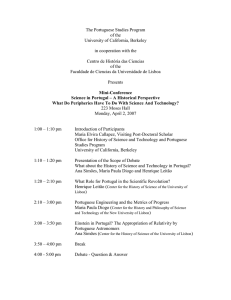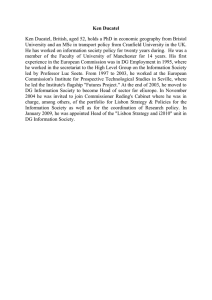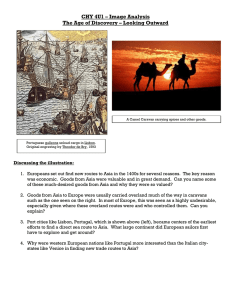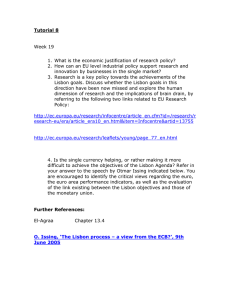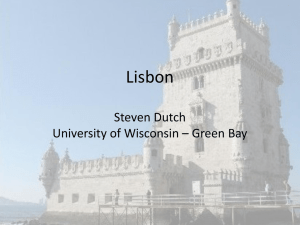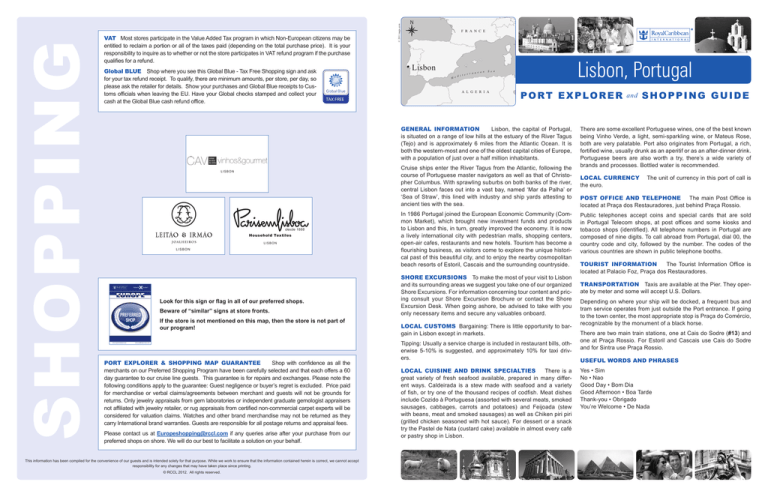
Global BLUE Shop where you see this Global Blue - Tax Free Shopping sign and ask
for your tax refund receipt. To qualify, there are minimum amounts, per store, per day, so
please ask the retailer for details. Show your purchases and Global Blue receipts to Customs officials when leaving the EU. Have your Global checks stamped and collect your
cash at the Global Blue cash refund office.
© 2011 maps.com
SHOPPING
VAT Most stores participate in the Value Added Tax program in which Non-European citizens may be
entitled to reclaim a portion or all of the taxes paid (depending on the total purchase price). It is your
responsibility to inquire as to whether or not the store participates in VAT refund program if the purchase
qualifies for a refund.
F R A N C E
Lisbon
n e a n
e r r a
d i t
M e
A L G E R I A
TAX FREE
Lisbon, Portugal
S e a
PORT EXPLORER
GENERAL INFORMATION
Lisbon, the capital of Portugal,
is situated on a range of low hills at the estuary of the River Tagus
(Tejo) and is approx­i­mately 6 miles from the Atlantic Ocean. It is
both the western-most and one of the oldest capital cities of Europe,
with a population of just over a half million inhabitants.
Cruise ships enter the River Tagus from the Atlantic, following the
course of Portuguese master navigators as well as that of Christopher Columbus. With sprawling suburbs on both banks of the river,
central Lisbon faces out into a vast bay, named ‘Mar da Palha’ or
‘Sea of Straw’, this lined with industry and ship yards attesting to
ancient ties with the sea.
LI S B O N
Household Textiles
LI S B O N
LISBON
Look for this sign or flag in all of our preferred shops.
Beware of “similar” signs at store fronts.
If the store is not mentioned on this map, then the store is not part of
our program!
Port Explorer & Shopping Map Guarantee
Shop with confidence as all the
merchants on our Preferred Shopping Program have been carefully selected and that each offers a 60
day guarantee to our cruise line guests. This guarantee is for repairs and exchanges. Please note the
following conditions apply to the guarantee: Guest negligence or buyer’s regret is excluded. Price paid
for merchandise or verbal claims/agreements between merchant and guests will not be grounds for
returns. Only jewelry appraisals from gem laboratories or independent graduate gemologist appraisers
not affiliated with jewelry retailer, or rug appraisals from certified non-commercial carpet experts will be
considered for valuation claims. Watches and other brand merchandise may not be returned as they
carry International brand warranties. Guests are responsible for all postage returns and appraisal fees.
Please contact us at Europeshopping@rccl.com if any queries arise after your purchase from our
preferred shops on shore. We will do our best to facilitate a solution on your behalf.
This information has been compiled for the convenience of our guests and is intended solely for that purpose. While we work to ensure that the information contained herein is correct, we cannot accept
responsibility for any changes that may have taken place since printing.
© RCCL 2012. All rights reserved.
In 1986 Portugal joined the European Economic Community (Common Market), which brought new investment funds and products
to Lisbon and this, in turn, greatly improved the economy. It is now
a lively international city with pedestrian malls, shopping centers,
open-air cafes, restaurants and new hotels. Tourism has become a
flourishing business, as visitors come to explore the unique historical past of this beautiful city, and to enjoy the nearby cosmopolitan
beach resorts of Estoril, Cascais and the surrounding countryside.
SHORE EXCURSIONS To make the most of your visit to Lisbon
and its surrounding areas we suggest you take one of our organized
Shore Excursions. For information concerning tour content and pricing consult your Shore Excursion Brochure or contact the Shore
Excursion Desk. When going ashore, be advised to take with you
only necessary items and secure any valuables onboard.
LOCAL CUSTOMS Bargaining: There is little opportunity to bargain in Lisbon except in markets.
Tipping: Usually a service charge is included in restaurant bills, otherwise 5-10% is suggested, and approximately 10% for taxi drivers.
Local Cuisine and Drink Specialties
There is a
great variety of fresh seafood available, prepared in many different ways. Caldeirada is a stew made with seafood and a variety
of fish, or try one of the thousand recipes of codfish. Meat dishes
include Cozido à Portuguesa (assorted with several meats, smoked
sausages, cabbages, carrots and potatoes) and Feijoada (stew
with beans, meat and smoked sausages) as well as Chiken piri piri
(grilled chicken seasoned with hot sauce). For dessert or a snack
try the Pastel de Nata (custard cake) available in almost every café
or pastry shop in Lisbon.
and
S H O PP I N G G U I D E
There are some excellent Portuguese wines, one of the best known
being Vinho Verde, a light, semi-sparkling wine, or Mateus Rose,
both are very palatable. Port also originates from Portugal, a rich,
fortified wine, usually drunk as an aperitif or as an after-dinner drink.
Portuguese beers are also worth a try, there’s a wide variety of
brands and processes. Bottled water is recommended.
LOCAL CURRENCY
the euro.
The unit of currency in this port of call is
POST OFFICE AND TELEPHONE
The main Post Office is
located at Praça dos Restauradores, just behind Praça Rossio.
Public telephones accept coins and special cards that are sold
in Portugal Telecom shops, at post offices and some kiosks and
tobacco shops (identified). All telephone numbers in Portugal are
composed of nine digits. To call abroad from Portugal, dial 00, the
country code and city, followed by the number. The codes of the
various countries are shown in public telephone booths.
TOURIST INFORMATION
The Tourist Information Office is
located at Palacio Foz, Praça dos Restauradores.
TRANSPORTATION Taxis are available at the Pier. They operate by meter and some will accept U.S. Dollars.
Depending on where your ship will be docked, a frequent bus and
tram service operates from just outside the Port entrance. If going
to the town center, the most appropriate stop is Praça do Comércio,
recognizable by the monument of a black horse.
There are two main train stations, one at Cais do Sodre (#13) and
one at Praça Rossio. For Estoril and Cascais use Cais do Sodre
and for Sintra use Praça Rossio.
USEFUL WORDS and phrases
Yes • Sim
No • Nao
Good Day • Bom Dia
Good Afternoon • Boa Tarde
Thank-you • Obrigado
You’re Welcome • De Nada
The SIGHTS and SHOPPING of LISBON
3
4
5
6
a
Alfama is the oldest quarter in Lisbon and is situated on the slopes below St. George’s Castle. It is a
labyrinth of narrow streets and alleys, and is considered by many to be one of the most colorful spots in
the City and the popular site of Fado music. Although some medieval mansions and Moorish buildings
survived the great earthquake, most of the houses date from the 18th century.
�
Lisbon Cathedral (Sé), located on Largo da Sé, dates from the 12th century and is Lisbon’s
oldi Information
est church. It suffered much earthquake damage in 1755, but was rebuilt in the 18th century. It is of a
solid, massive construction with battlements and towers. Inside is the baptismal font of St. Anthony of
Padua (Portugal’s Patron Saint who was born in Lisbon), and also in the Cathedral are the relics of St.
Vincent, the City’s Patron Saint.
Tourist
Coisas do Arco do Vinho
Rua Bartolomeu Dias Loja, 7
This wine store is located in the Centro Cultural de Belem, near the Maritime Museum
and Jeronimos Monastery. Dedicated to
the promotion of fine Portuguese wines, this
wine shop is considered one of the best in
Lisbon. They specialize in Porto and regional selections. Wine aficionados can also find
the perfect set of glasses, carafes and wine
books from their bookshop.
b
Leitao & Irmao Jewelry
Largo do Chiado, 16 & 17
This distinguished jewelry company was established at the end of the 18th century and
is recognized the world over for their fine
craftmanship of filigree gold jewelry as well
as traditional pieces with a variety of gemstones. They were granted the recognition
of Brazil back in 1873 as the goldsmiths of
the Imperial House of Brazil and later gained
the same recognition in 1887 as the Jewellers to the Portuguese Crown. You can shop
with confidence at this jewelry institution with
their own workshop. Exclusive gift with purchase will be given to our cruise line guests as
follows:
· For purchases over € 250 – a necklace with a
bar of pure silver with 2.5 gr weight
· For purchases over € 500 - a necklace with a
bar of pure silver with 5gr weight
· For purchases over € 1,000 - a necklace with
a bar of pure silver with 10gr weight
Calouste Gulbenkian Museum, is situated in the north section of the City on Avenida de Berna. Set in pleasant gardens, this museum houses Gulbenkian’s private collection of Islamic, Greek and
Roman art, as well as decorative arts. Centro de Arte Moderna (Modern Art Center) is situated next to
the Gulbenkian Museum and houses the most significant works of Portuguese painters and sculptors
of this century. Entrance off Rua Dr. Nicolau Bettencourt.
Museu da Cidade (City Museum) is in Palacio Pimenta, Campo Grande, with maps, engravings
and other objects showing the development of Lisbon.
c
Parisemlisboa - Rua Garrett, 77
This iconic Portuguese shop has sold household textiles since 1888. Among their specialties found are pure cotton, wool, and silk bed
sets, sheets, covers, towels, rugs, robes and
pyjamas. Accessories and fragrances from local Portuguese and world-wide brands are also
available.
25th April Bridge spans the Tagus river near the Ship’s terminal. Built in the 1960’s, it is the third
longest suspension bridge in the World. On the far side is the statue of ‘Christ the King’, a monument
celebrating Portugal’s neutrality during World War II.
4
Belem is a suburb of Lisbon, a few miles down the river from the Terminal. It was from here that the ship’s of
Vasco da Gama and other famous explorers set sail for the New World.
8
9
10
11
Belem Tower was built between 1515 and 1521. This five story tower stands on the banks of the
Tagus River, just west of the Monument to the Discoveries. Built to protect the river entrance from
pirates, it later functioned as a prison.
Mosteiro dos Jerónimos (Hieronymite Monastery) also in Belem, in Praça do Imperio, is a
limestone monastery founded in 1502 by King Manuel I during the prosperous Era of the Discoveries. It is one of Lisbon’s great landmarks and is considered the country’s finest example of manueline
architecture. The tombs of King Manuel I and several other monarchs, as well as Vasco da Gama, can
be found in the church.
Museu Nacional dos Coches (National Coach Museum) at Praça Afonso de Albuquerque in
Belem, is considered by many to be the finest coach collection in the world. It is situated in the former
riding school of the old Royal Palace. The collection contains coaches from the 16th through 19th
centuries.
Museu da Marinha (Maritime Museum) is located next to the monastery. This museum contains
small models of boats from all eras of Portuguese history and other naval marine equipment. Real
boats are exhibited in the modern extension.
D
National Museum of Ancient Arts - The museum collection includes paintings, sculptures,
metalwork, textiles, furniture, drawings, and other decorative arts from the Middle Ages to the early
nineteenth century. The collections, especially those for the fifteenth and sixteenth centuries,E
are particularly important regarding the history of Portuguese painting, sculpture, and metalwork.
Beyond Lisbon
F
Fatima, approximately 150 miles north of Lisbon, is one of the most significant centers of pilgrimage
G in the
Catholic world. The village was the scene of purported sightings of the Virgin Mary in 1917. These sightings
were readily accepted after thousands of people witnessed the miracle of the sun spinning out of its
Haxis. In
the center of the village is an impressive modern basilica and a central square capable of holding crowds up
to 100,000 during the pilgrimages of May and October each year.
I
J
K
L
M
Calç
9
11
12
8
do C
omb
B
ro
C
1
2
3
10
A
7
ada
13
6
© 2011 maps.com
12
5
Monument to the Discoveries, situated in Belem, is a modern sculpture by the river-side, in
the shape of a caravel and comprises various historic figures who were involved in the discovery of
‘new lands’. Prince Henry the Navigator is on the prow. The huge monolith was built a few years ago
to commemorate the 500th anniversary of the first voyage sponsored by the Prince. An elevator inside
the monument offers panoramic views of the area.
�
7
�
2
Castle of St. George (Castelo de São Jorge) stands on the hill where it is believed the original
Phoenician colony was established. The Romans built the first defensive walls here, but little evidence
of this remains. The present castle was built in the 12th century and was dedicated to St. George in the
14th century. It is a very impressive building with 10 towers, linked by massive battlements. There are
wonderful views of Lisbon from the Castle, one of the few structures to survive the 1755 earthquake.
Situated on Rua Costa do Castel.
�
1
Batalha lies to the north of Lisbon and is home to the Abbey of Batalha. Founded to commemorate the
battle which sealed Portugal’s independence from Spanish rule, the abbey is a symbol of national pride and
the final resting place of Henry the Navigator.
Queluz, 8 miles north-west of Lisbon, is the home of the Palacio Nacional, an 18th century pink rococo
palace, furnished with Portuguese Empire antiques. The beautiful gardens are laid out according to what was
fashionable at the time.
Estoril is approximately 16 miles west of Lisbon, and is a cosmo­politan resort with good beaches, palm
lined avenues, beautiful villas, luxurious hotels, two golf courses, and the casino.
Sintra, lies in the mountains, 18 miles north-west of Lisbon and is one of Portugal’s oldest towns, truly
enchanting as well as beautiful. Sintra Palace lies in the main square, dating from the 14th century, it was
the summer residence of the Kings of Portugal for six centuries. Pena Palace stands high on a peak above
Sintra, built in the mid-19th century by King Ferdinand, around a former 16th century monastery. There are
spectacular views from the Palace verandas.
Cascais is 2 miles further west of Estoril. Once a simple fishing village, it evolved during this century into
a beach resort. It has excellent restaurants, bars and nightclubs. Water sports and sailing are available from
its beaches.

